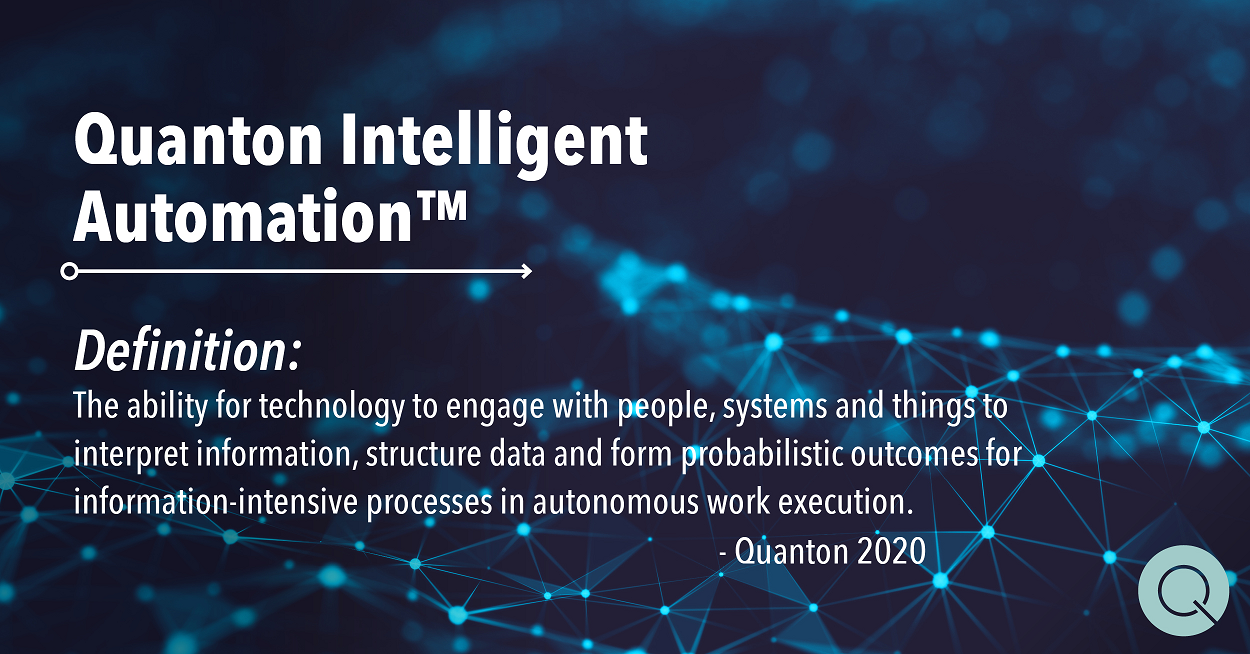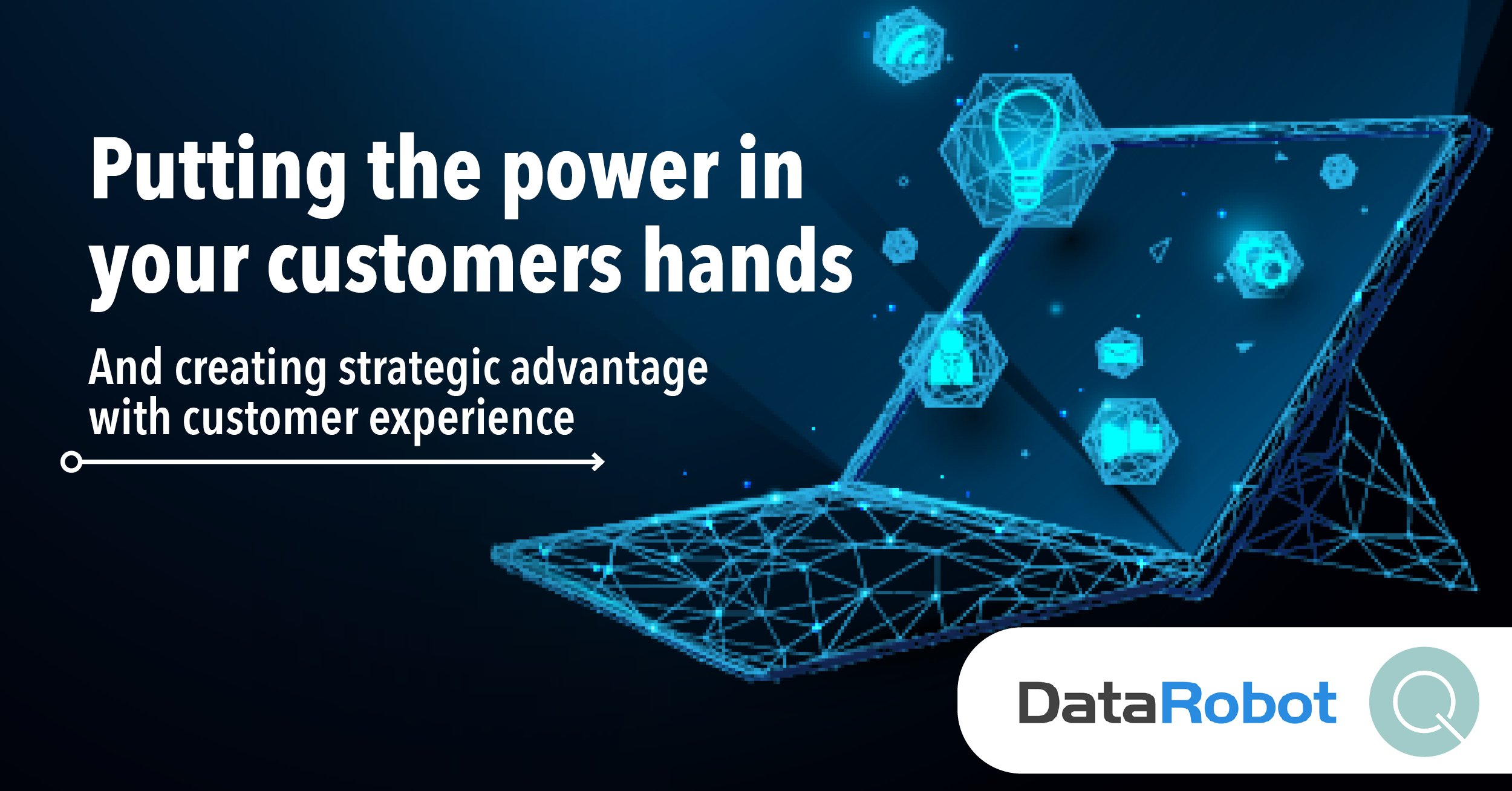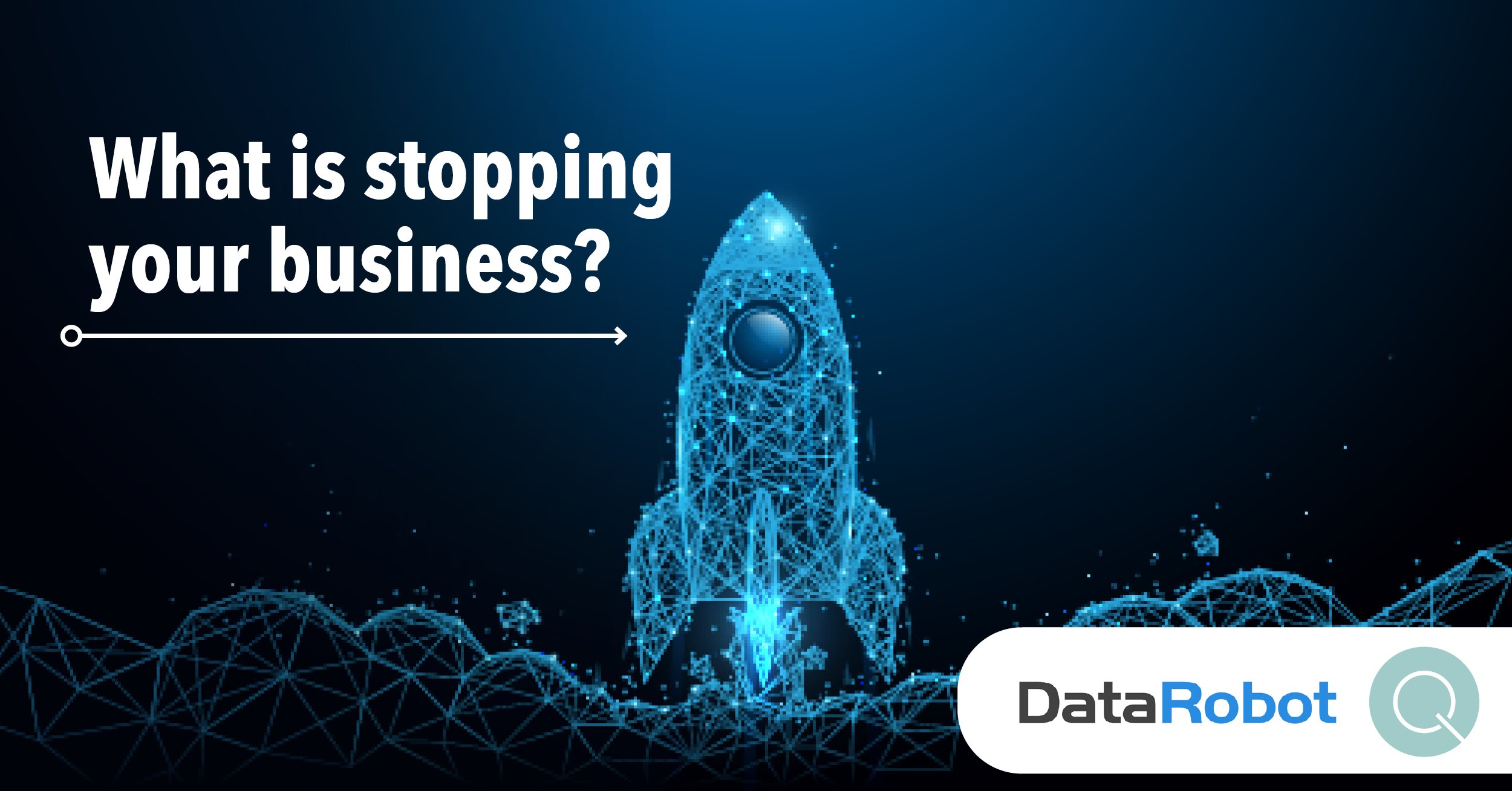
Colin Priest, VP of AI Strategy for DataRobot and evangelist for Intelligent Automation shares his perspectives on the future of business process automation with Intelligent Automation.
Technology advancements over the past two-three years mean that Intelligent Automation is more accessible and practical than ever; we have moved past the hype, but adoption is still limited to the innovators and there are barriers for businesses.
For the early adopters who are prepared to push the limits and boundaries, Colin offers his thoughts on what it takes to start with an IA journey.
I met Colin through our shared interest in Intelligent Automation and quickly found we share very similar views which helped to shape my own thinking in the final stages of developing the Quanton Intelligent Automation™ model.
In this article we share some views and perspectives from DataRobot's, Colin Priest, to help shape the thinking of the innovators and initiators in the market to understand what is practically possible now and what can be achieved.
Editors note: The video shown is a highlights video. The full 45-minute conversation can also be viewed on YouTube.
Defining Intelligent Automation
For the past three-five years the market has been talking about Intelligent Automation. The commonly accepted definition would be the use of AI within business process automation.
At a broad level there is acceptance for this definition, but disparity can exist in the exact definition, depending on the individual perspective of what ‘AI’ means.
According to Colin, “Intelligent Automation is when your system is able to start doing things that historically would have required human decision making.”
And, [Intelligent Automation] “enables automation to move beyond processes purely based on structured data and rules, to processes and use-cases that require more complex decision making and the application of unstructured data."
All of which is very much in line with our own definition of Intelligent Automation:

Using Intelligent Automation to create strategic advantage
The ability to automate customer service processes and interactions is one of the places we see as holding the greatest opportunities for IA. And the customer experience is becoming one of the biggest battle grounds for businesses and offering a superior experience is a strategic competitive advantage.
What’s more important is that your experience is not going to be measured by what your competitors are doing, it will be measured against best in class experiences, even if they are in unrelated sectors or even other countries.
If people are getting a better experience that they are not getting from you, even if using a different service set, it is going to start affecting customer satisfaction because people know what is relatively available.
“Businesses need automation capability that is capable of addressing a wider range of use cases, particularly those processes that deal with humans, because humans are complex” and Intelligent Automation can enable exactly this.
The first step might be automating processes in their current state, which would deliver immediate benefit necessarily to customers and businesses.

Customers’ needs are becoming increasingly complex and their expectations are continually evolving. The opportunity is to move beyond addressing people through ‘templated’ and ‘standardised’ processes. Indeed, the promise of Intelligent Automation is the ability to offer personalised experiences at scale.
Applying the Quanton Intelligent Automation™ model to customer service also opens the spectrum of service delivery from reactive to pro-active.
Coupling IA capability to customer services creates the potential to make personalised recommendations, solve customer service issues as they occur based on alerts or even predict when a customer is likely to experience a problem and pro-actively intervene.
There is a seemingly limitless transformation potential for the application of IA to customer service.
Intelligent Automation is still in the early stages of adoption and its not limited to large enterprise
According to Colin Intelligent Automation is still in the early stages of adoption globally because most people haven’t necessarily realised that it is practical.
This is a sentiment that I certainly agree with but I have also been bold enough to claim that I do not believe there are any examples in New Zealand where IA capability has been successfully implemented and scaled. In this sense, while we may be in the early stages of adoption globally New Zealand is lagging in this space.
Colin’s observation is that we are increasingly seeing IA solutions and initial capability appearing in larger enterprises but establishing and benefiting from capability is not necessarily limited to the largest enterprises. IA capability is a realist for large and even medium businesses in the New Zealand landscape.
Large and medium businesses may even be at an advantage when it comes to the adoption of Intelligent Automation capability. I have long held the view that traditional enterprises are constrained by their organisational structures and governance processes.
I believe that many large businesses, who have relatively simpler and necessarily flatter structures can be far more agile – that is they can make decisions and implement change faster. And I am seeing this with many of the large business clients we are working with, Toyota Finance New Zealand being a prime example.
The technology companies themselves are also aware that their future growth prospects will come from segments of the market under the enterprise layer and to leverage this opportunity we’re seeing platforms evolve in ways that make their offerings easier to access and apply. Some examples that substantiate this would be the ability to access AI capabilities as SaaS services or from managed service providers.
We’ve found there is still a floor in New Zealand, a point where the application of capability does not add value but technologies will continue you evolve with different service models and provide businesses with a greater variety of ways to access capability in the future.
What is holding the adoption of Intelligent Automation up?

Colin believes there are two big problems. The first is education - people don’t know enough, and the second arises when businesses treat Intelligent Automation like a technology project.
“Where to start, what is possible, what the risks are and how to successfully achieve benefit.”
“It can be very difficult for business leaders to make a decision to go forwards when they don’t understand something.” The solution at this level is investment, not into technology itself, but into education around a technology capability.
The second is that too often it is treated as or becomes a technology project.
There is a long- standing discussion in the market around weather automation is a technology project or a business project. I hold the view that automation is a business led, technology supported project.
Businesses make the mistake of thinking that because automation is technology enabled that the technology is the most important part. This is wrong. When you talk in terms of automation you are addressing business processes and more important that processes you are discussing business outcomes and business outputs. The business is responsible for these factors.
Make no mistake, though, that IA capability will not be successful without technology and support from the technology team. Technology still must be secured, governed, hosted and supported.
For IA capability to be successful, like with any automation programme in general, both technology and the business must work together – and be focussed on the outcome. And the outcome needs to be a business outcome, not a technology outcome. There needs to be clear business goals.
Building Intelligent Automation capability is a transformative journey
- Intelligent Automation is a capability, not a solution.
- Intelligent Automation is made possible through multiple technologies used in combination.

IA capability is not necessarily about the implementation of an entirely new set of technologies. It is very likely than many of the technologies that a business would require are already in their technology stack.
The challenges will come from whether these technologies capabilities are working by themselves individually and at scale before we begin to look at how they will work in combination with other technologies.
Building a solution is not hard, but building a capability based on multiple capabilities with inter-related technologies within a highly scalable framework is hard.
“We need a lot more of thinking through at a holistic level what things should look like. It’s about having a very clear vision for what you want to deliver, and what you want to achieve.” And then understanding the holistic requirements of people, processes, technology and data – and what governance is required to support a transformation.
Our observation of the market is that the businesses who do not put these foundations in place are often the ones who fail to achieve benefit, fail to scale their programmes or fail to reach the anticipated potential.
I have always advocated and like any form of transformation, creating IA capability is a journey, a sentiment Colin shared when he said “We have to think of it as more of a bunch of small steps.”
But businesses also have to be realistic in their expectation. “It won’t solve all of your problems, but it will start to solve a wider and wider range of use cases.”
We like to take a pragmatic approach to the market, and we would re-enforce a key message that there still are no silver bullets. While I believe that it is a strategic enterprise capability, it is still a part of a holistic operating model.
Three pieces of advice on how to think about starting
For the innovators, the disruptors and the change agents in New Zealand businesses, Colin offered three simple pieces of advice to help you approach your own transformative journey in the development of IA capability.
- Make sure what you are doing is business driven, not technology driven.
Automation is not about the technology. It’s about the process, the business outcomes. We would extend that by saying that transformation only occurs when technology, data, processes and people are brought together in the perfect blend.
- Be very clear what the capability has to deliver for your business.
Understand what you want Intelligent Automation to do for your business. Why you are building an IA capability, what benefits it has to deliver and how it aligns to your strategic drivers.
- Put proper governance in place and be very clear on what your ethical values are.
You are creating a capability which in part is based on artificial intelligent and is capable of automated ‘decision making. If you haven’t defined your ethical values are, there is your IA capability can act consistently with them.
Editors note: Colin and I had a strong discussion around ethics in AI and how they relate to Intelligent Automation. For people embarking on an Intelligent Automation journey this is a really important consideration and we would encourage you to understand the discussion on ethics, how it relates to your business and how you will reflect the relevant considerations in your own governance.

Intelligent Automation can be a strategic capability which helps organisations shape their future operating models.
Necessarily IA was more hype that reality three-five years ago, but that’s a long time in the technology sector. It’s not a silver bullet but the application of IA to deliver tangible business benefit is a practical reality.
True IA is a capability and a transformative journey. For innovators and initiators out there who are wondering if IA can help them transform their business, we dig into all of these topics a little more in our 2020 Guide to Intelligent Automation.



